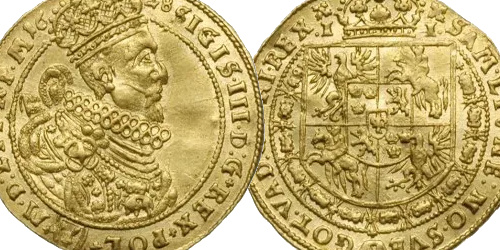A very rare variant of the dime with the facsimile signature of F. Malinowski reversed by 180°.
Banknote broken by a printed field.
A natural piece.
A variety practically unlisted on the auction market.
A very rare item that will enrich any collection of Kosciuszko Insurrection tickets.
In the Polish lands, the introduction of paper money into circulation was connected with expenses related to the outbreak of the Kosciuszko Insurrection. Its issuer was the Directorate of Treasury Tickets established by the Supreme National Council. In terms of value, treasury tickets were equated with coinage. Obligations to the Treasury could be paid a maximum of 50% in paper money and the remainder in coins. This condition resulted in its negative reception by the public. In the future, the redemption of treasury tickets was to be financed from national wealth. For counterfeiting paper money, the death penalty was stipulated, as well as confiscation of all the perpetrator's property. On September 29, 1794, in order to strengthen confidence in treasury tickets, the National Supreme Council authorized the regulation of the entire amount in paper pennies and zlotys. Due to the failures of the uprising, public confidence in paper money was declining. The population preferred to accept bullion money in settlements. The range of issuance of the first Polish paper money was small - it was introduced on a large scale only in Warsaw. After the capture of the capital on November 6, 1794, tickets of all denominations for a total of 7.8 million Polish zlotys remained in the hands of the population.
Due to the shortage of small copper coinage, it was decided to issue paper penny denominations and lower values amounting to 1 Polish zloty. They were printed on two separate sheets of paper. A security mark in the form of a Roman numeral with the value of the denomination was printed on the top side of the reverse. In the case of the zloty, this was the notation "Z³:

format_quoteAn extremely rare piece of a pass ticket with a denomination of 10 pennies, created by defective gluing of two layers of paper. Stamped domestic paper, produced by a paper mill in Jeziorna near Warsaw, was used to print the 5, 10 grosz and 4 zloty pass tickets. The actual page of the pass tickets was printed using the combined typographic method, with the use of cast fonts and decorative elements, as well as woodcuts. The reverse side of the ticket was prepared on a separate sheet of paper, on which the facsimile signature of Commissioner Filip Malinowski (F. Malinowski) was stamped. On one of the sheets an additional security feature was applied in the form of an imitation watermark, produced by a chemical method. This mark took the form of a denomination surrounded by a simple rosette. The sheets were then glued together and after drying were cut into bundles. The finished pass ticket thus consists of two joined sheets of handmade paper. It is extremely rare to find tickets glued together defectively, where the sheet with the facsimile of the signature has been turned 180 o. It is known that a full set of pass tickets was printed on a single sheet of handmade paper, of which the lower denominations (5 and 10 pennies) had no additional letter markings, and the higher denominations: 1 and 4 zloty had such letter markings. In the case of 5 and 10 pennies, the sheet contained 36 tickets. Hence, the total number of pass tickets with a denomination of 10 pennies with an inverted signature was no less than 36 piecesformat_quote











